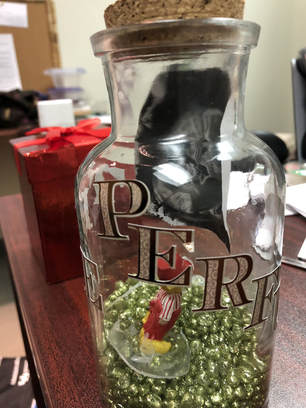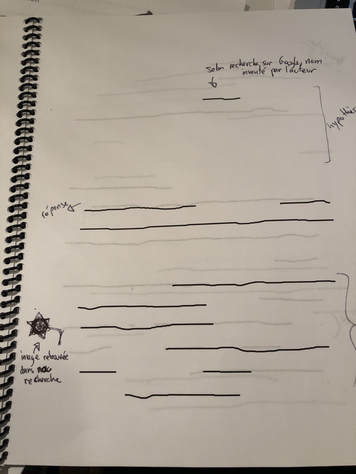On this page you will find a description of my overall approach in the classroom and my interdisciplinary multimedia online projects, courses I have taught at Concordia University and a selection of pictures of alternative reactions that students created in my courses. I am currently producing my own instructional videos for language and culture classes, which I film in music clubs, on the street, in restaurants, and bars in Augsburg. Students immerse themselves in the world of the videos, edit them and create language in dialogue with the virtual narrative. I also include live FaceTime calls in my language courses with German natives who are willing to film real world situations with the camera and interact with students.
° ° In our Classroom
I try to present some secrets of German culture, particular ways of perceiving the world and to spark the students’ interest to discover a new culture. I am convinced that contrasting one’s own culture with a foreign culture not only broadens horizons and increases awareness, but it can also simply be a fun adventure.
° ° Diversity
Methods
° ° Rhizomatic Response Projects (RRPs)
° Inspired from the Digital Humanities and Cultural Studies
Rhizomatic Response Projects are alternative interdisciplinary and creative multimedia reactions to the assigned readings, which are documented online. These team projects are a crucial part of my innovative teaching and are to provide a broader understanding of the text as a cultural artifact that communicates with other discourses. As a form of a creative cross-disciplinary online multimedia reaction, RRPs focus on the relationship between particular aspects of the readings (fictional & theoretical) and one or more cultural ob- jects relevant to the subject at hand. Students research links between other related disciplines, arts, or forms of media in order to find creative ways to express essential ideas or questions raised by a text. For example, one project on Goethe’s Faust initiated political as well as ethical reflections on the research of artificial life. By creating connections between a cultural artifact and related discourses, students are encouraged to think beyond the text, its author and the historical background. These projects have been very successful because they do not simply study theory, they bring it into practice by generating thoughtful reflection and representation of key concepts. All RRPs must include visual and/or audiovisual elements.
Courses taught at Concordia University
FALL 2017
German Women Writers across the Ages
(Inspired from Cultural Studies & Digital Humanities)
This course investigates the changing literary and social roles of German women from the 18th to the 21st century. Selected readings of women’s literary and cultural productions will also illustrate the history of gender coding from the period of Empfindsamkeit to the present. In addition to examining cultural artifacts, such as novels, plays, film scripts, paintings and advertisements, the course also offers an insight into the Feminist movement. An introduction to the main concepts of gender theory provides the basis to analyze the variety of gender identities and representations that are central to feminist theory. Learning about women in the arts and reflecting upon feminism includes questions of sex and gender but also other discourses, such as race, colonialism, politics, philosophy, class etc. Drawing on thought-provoking texts and visual artifacts, GERM 450 offers a diverse view of life in German-speaking countries from the perspective of women authors based on selections from literary and historical works, commentaries, and interdisciplinary materials, which highlight important cultural movements. The language of instruction is English, and no prior knowledge of the German language is required.
WINTER 2016
Of German Witches, Ghosts, Demons and Vampires
(Inspired from Cultural Studies & Digital Humanities)
This course explores how the strange, the magical, the supernatural and the uncanny (Das Unheimliche) are constructed in German texts and films, with a particular focus on the 1700s to the present. The subject matter will include a wide array of texts (novels, short stories, historic documents, fairy tales, films) that discuss the phenomena of witches, ghosts, daemons, spirits, and vampires. One crucial aspect is their function as a site for debates concerning the limits and definition of the human realm. Using tools such as readings, discussions, and creative multimedia assignments (Rhizomatic Response Projects), students will approach theoretical texts on the Fantastic and engage with cultural artifacts through the frame of the digital humanities. The language of instruction is English, and no prior knowledge of the German language is required.
Cyborgs, Robots and Automata in German Literature, Film and Video Games
(Inspired from Cultural Studies & Digital Humanities)
This course examines the figure of the android and explores representations of artificial beings in German literature, cinema, and video games. A focus is on issues of technology, human self-perception, art, gender, and race. Students receive insights into narrative constructions as well as ludology by exploring how video games challenge traditional models of understanding and approaching texts.
Introduction to Modern German Literature II
(Inspired from Cultural Studies & Digital Humanities)
This course provides a general overview of the major authors and trends of German literature in the 20th century within a historical and philosophical context. In order to work professionally with “cultural texts” students will read a broad range of theoretical texts on understanding, the nature of language, interpretation, and media. Furthermore, students learn about contemporary cultural movements and writing strategies.
FALL 2015
German Literature in Translation
This course focuses on reading and discussion of 20th & 21st century literary works and films from Germany, Austria, and Switzerland. Works translated from German are used. This course is taught in English, but advanced German students are encouraged to read the texts in German
Introduction to Translation
This course examines German and English grammar in a comparative context in order to provide a basis for translation between the two languages. It also aims to develop lexical and semantic knowledge of the German language through analysis of textual materials, with special focus on words and idiomatic expressions that are essential to clear and effective communication. Students translate short texts from a variety of fields, primarily from English to German.
German-speaking Exiles in Hollywood
This course introduces a selection of well- and less-known German-speaking authors and filmmakers, who immigrated to the United States during the rise of the Nazi- reign. Many of these exiled authors were Jews who fled persecution in Germany. As a group, they include many of the most important German literary and philosophical voices of the 20th century, including Theodor W. Adorno and Hannah Arendt, who reflected upon the fragility of democracy and the lure of totalitarianism. Based on a diverse corpus of sources, i.e. diary entries, literary as well as theoretical texts, and films students will discuss the meaning of exile. How is the loss of one’s home mirrored in the individual work, and “how much” of one’s identity is linked to the notion of “home”? Which factors constitute identity? Furthermore, we will problematize the notions of memory and autobiography.
I try to present some secrets of German culture, particular ways of perceiving the world and to spark the students’ interest to discover a new culture. I am convinced that contrasting one’s own culture with a foreign culture not only broadens horizons and increases awareness, but it can also simply be a fun adventure.
- Warm and open classroom atmosphere
- Diversity: students bring in their backgrounds and cultures
- Multi-component & interdisciplinary teaching: lectures & discussions, creative assignments, RRPS. The interdisciplinary projects entail peer reviews, interviews, digital story telling, online lectures etc.
- I interact with students in different environments: Stammtisch, film nights, cultural events in the city
- Independent & critical thinking
- Communicative competence
- Problem solving strategies
° ° Diversity
Methods
- Different components: lecture & discussion in groups, RRPs including digital story telling, text, video, images, interviews, real world applications & peer review, creative response projects, readings, online lectures. Students have different learning style. One example: creative response to Kafka's text The Cares of a Family Man: build the creature Odradek based on text passages .
- Change of location and new faces: I bring in authors, film makers, poetry slammers, and colleagues from other universities for readings, lectures, workshops or co-teaching a class.
- Students bring in their own backgrounds, cultures and family structures. In my "Reading Theory" course we did a "reality check" regarding Lacan’s interpretation of the family triangle structure.
- Critically check my own biases in syllabi
- Get to know my diverse students, their needs and their learning strategies:
° ° Rhizomatic Response Projects (RRPs)
° Inspired from the Digital Humanities and Cultural Studies
Rhizomatic Response Projects are alternative interdisciplinary and creative multimedia reactions to the assigned readings, which are documented online. These team projects are a crucial part of my innovative teaching and are to provide a broader understanding of the text as a cultural artifact that communicates with other discourses. As a form of a creative cross-disciplinary online multimedia reaction, RRPs focus on the relationship between particular aspects of the readings (fictional & theoretical) and one or more cultural ob- jects relevant to the subject at hand. Students research links between other related disciplines, arts, or forms of media in order to find creative ways to express essential ideas or questions raised by a text. For example, one project on Goethe’s Faust initiated political as well as ethical reflections on the research of artificial life. By creating connections between a cultural artifact and related discourses, students are encouraged to think beyond the text, its author and the historical background. These projects have been very successful because they do not simply study theory, they bring it into practice by generating thoughtful reflection and representation of key concepts. All RRPs must include visual and/or audiovisual elements.
Courses taught at Concordia University
FALL 2017
German Women Writers across the Ages
(Inspired from Cultural Studies & Digital Humanities)
This course investigates the changing literary and social roles of German women from the 18th to the 21st century. Selected readings of women’s literary and cultural productions will also illustrate the history of gender coding from the period of Empfindsamkeit to the present. In addition to examining cultural artifacts, such as novels, plays, film scripts, paintings and advertisements, the course also offers an insight into the Feminist movement. An introduction to the main concepts of gender theory provides the basis to analyze the variety of gender identities and representations that are central to feminist theory. Learning about women in the arts and reflecting upon feminism includes questions of sex and gender but also other discourses, such as race, colonialism, politics, philosophy, class etc. Drawing on thought-provoking texts and visual artifacts, GERM 450 offers a diverse view of life in German-speaking countries from the perspective of women authors based on selections from literary and historical works, commentaries, and interdisciplinary materials, which highlight important cultural movements. The language of instruction is English, and no prior knowledge of the German language is required.
WINTER 2016
Of German Witches, Ghosts, Demons and Vampires
(Inspired from Cultural Studies & Digital Humanities)
This course explores how the strange, the magical, the supernatural and the uncanny (Das Unheimliche) are constructed in German texts and films, with a particular focus on the 1700s to the present. The subject matter will include a wide array of texts (novels, short stories, historic documents, fairy tales, films) that discuss the phenomena of witches, ghosts, daemons, spirits, and vampires. One crucial aspect is their function as a site for debates concerning the limits and definition of the human realm. Using tools such as readings, discussions, and creative multimedia assignments (Rhizomatic Response Projects), students will approach theoretical texts on the Fantastic and engage with cultural artifacts through the frame of the digital humanities. The language of instruction is English, and no prior knowledge of the German language is required.
Cyborgs, Robots and Automata in German Literature, Film and Video Games
(Inspired from Cultural Studies & Digital Humanities)
This course examines the figure of the android and explores representations of artificial beings in German literature, cinema, and video games. A focus is on issues of technology, human self-perception, art, gender, and race. Students receive insights into narrative constructions as well as ludology by exploring how video games challenge traditional models of understanding and approaching texts.
Introduction to Modern German Literature II
(Inspired from Cultural Studies & Digital Humanities)
This course provides a general overview of the major authors and trends of German literature in the 20th century within a historical and philosophical context. In order to work professionally with “cultural texts” students will read a broad range of theoretical texts on understanding, the nature of language, interpretation, and media. Furthermore, students learn about contemporary cultural movements and writing strategies.
FALL 2015
German Literature in Translation
This course focuses on reading and discussion of 20th & 21st century literary works and films from Germany, Austria, and Switzerland. Works translated from German are used. This course is taught in English, but advanced German students are encouraged to read the texts in German
Introduction to Translation
This course examines German and English grammar in a comparative context in order to provide a basis for translation between the two languages. It also aims to develop lexical and semantic knowledge of the German language through analysis of textual materials, with special focus on words and idiomatic expressions that are essential to clear and effective communication. Students translate short texts from a variety of fields, primarily from English to German.
German-speaking Exiles in Hollywood
This course introduces a selection of well- and less-known German-speaking authors and filmmakers, who immigrated to the United States during the rise of the Nazi- reign. Many of these exiled authors were Jews who fled persecution in Germany. As a group, they include many of the most important German literary and philosophical voices of the 20th century, including Theodor W. Adorno and Hannah Arendt, who reflected upon the fragility of democracy and the lure of totalitarianism. Based on a diverse corpus of sources, i.e. diary entries, literary as well as theoretical texts, and films students will discuss the meaning of exile. How is the loss of one’s home mirrored in the individual work, and “how much” of one’s identity is linked to the notion of “home”? Which factors constitute identity? Furthermore, we will problematize the notions of memory and autobiography.
German 230: German Literature in Translation (FALL 2017). Creative Responses
1. "Return to the Whomb" Creative Response to Das Parfüm by Kasandra Leticia Samayoa Muñoz (2017)
2. "From Claude with love.." Creative Response to Finsterworld by Benedicte Audet (2017)
3. "Gregor Samsa is dead" Creative Response to "Die Verwandlung" by Victoria Bolanos-Roberts
4. Underline what's important in Kafka's The Cares of a Family Man! We all did. Now, the text just disappeared. Creative Response "Un guide pour comprendre Odradek de Kafka" by Claudia Persechino (2017)
1. "Return to the Whomb" Creative Response to Das Parfüm by Kasandra Leticia Samayoa Muñoz (2017)
2. "From Claude with love.." Creative Response to Finsterworld by Benedicte Audet (2017)
3. "Gregor Samsa is dead" Creative Response to "Die Verwandlung" by Victoria Bolanos-Roberts
4. Underline what's important in Kafka's The Cares of a Family Man! We all did. Now, the text just disappeared. Creative Response "Un guide pour comprendre Odradek de Kafka" by Claudia Persechino (2017)




